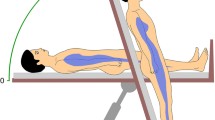Abstract
Objective
To determine whether the heart rate changes during tilt table testing could be used in the differential diagnosis between vasovagal syncope and chronic autonomic failure.
Methods
We compared the relationship between electrocardiographic R-R intervals and beat-to-beat blood pressure in 43 patients with typical vasovagal responses and 30 patients with chronic autonomic failure (6 pure autonomic failure, 23 multiple system atrophy, and 1 Parkinson’s disease).
Results
In every patient with vasovagal syncope, at the time when the blood pressure was falling, it was possible to identify at least 12 successive heart beats (mean 33 ± 2 heart beat, range 12–57) when blood pressure and heart rate fell in parallel, i.e., there was a negative relationship between blood pressure and R-R intervals (P < 0.001). In contrast, the relationship between blood pressure and R-R intervals in patients with chronic autonomic failure was never negative, i.e., heart rate always increased, albeit less than expected for the given fall in blood pressure, or remained unchanged.
Interpretation
The heart rate changes during the fall in blood pressure can distinguish patients with vasovagal responses from those with chronic autonomic failure.


Similar content being viewed by others
References
Brignole M, Menozzi C, Del Rosso A, Costa S, Gaggioli G, Bottoni N, Bartoli P, Sutton R (2000) New classification of haemodynamics of vasovagal syncope: beyond the VASIS classification. Analysis of the pre-syncopal phase of the tilt test without and with nitroglycerin challenge. Vasovagal Syncope International Study. Europace 2:66–76
Colman N, Nahm K, Ganzeboom KS, Shen WK, Reitsma J, Linzer M, Wieling W, Kaufmann H (2004) Epidemiology of reflex syncope. Clin Auton Res 14(suppl 1):9–17
Colman N, Nahm K, van Dijk JG, Reitsma JB, Wieling W, Kaufmann H (2004) Diagnostic value of history taking in reflex syncope. Clin Auton Res 14(suppl 1):37–44
Cotton TF, Lewis T (1918) Observations upon fainting attacks due to inhibitory cardiac impulses. Heart 7:23–34
Jardine DL, Ikram H, Crozier IG (1996) Autonomic control of asystolic vasovagal syncope. Heart 75:528–530
Jardine DL, Ikram H, Frampton CM, Frethey R, Bennett SI, Crozier IG (1998) Autonomic control of vasovagal syncope. Am J Physiol 274:H2110–H2115
Kaufmann H (1997) Syncope. A neurologist’s viewpoint. Cardiol Clin 15:177–194
Kaufmann H, Biaggioni I (2003) Autonomic failure in neurodegenerative disorders. Semin Neurol 23:351–363
Kaufmann H, Hainsworth R (2001) Why do we faint? Muscle Nerve 24:981–983
Kaufmann H, Nahm K, Purohit D, Wolfe D (2004) Autonomic failure as the initial presentation of Parkinson disease and dementia with Lewy bodies. Neurology 63:1093–1095
Kurbaan AS, Bowker TJ, Wijesekera N, Franzen AC, Heaven D, Itty S, Sutton R (2003) Age and hemodynamic responses to tilt testing in those with syncope of unknown origin. J Am Coll Cardiol 41:1004–1007
Lewis T (1932) A lecture on vasovagal syncope and the carotid sinus mechanism with comments on Gowers’ and Nothnagel’s syndrome. Br Med J 1:873–876
Matsukawa T, Sugiyama Y, Mano T (1996) Age-related changes in baroreflex control of heart rate and sympathetic nerve activity in healthy humans. J Auton Nerv Syst 60:209–212
Morillo CA, Eckberg DL, Ellenbogen KA, Beightol LA, Hoag JB, Tahvanainen KU, Kuusela TA, Diedrich AM (1997) Vagal and sympathetic mechanisms in patients with orthostatic vasovagal syncope. Circulation 96:2509–2513
Romme JJ, van Dijk N, Boer KR, Dekker LR, Stam J, Reitsma JB, Wieling W (2008) Influence of age and gender on the occurrence and presentation of reflex syncope. Clin Auton Res 18:127–133
Sutton R, Perrins J, Clarke M, Cobbe SM, Charles RG (1992) Recommendations for pacing. BMJ 305:1432
Suzuki M, Hori S, Nakamura I, Nagata S, Tomita Y, Aikawa N (2003) Role of vagal control in vasovagal syncope. Pacing Clin Electrophysiol 26:571–578
Acknowledgments
Supported in part by NIH Grant R01 DC 04212.
Author information
Authors and Affiliations
Corresponding author
Rights and permissions
About this article
Cite this article
Téllez, M.J., Norcliffe-Kaufmann, L.J., Lenina, S. et al. Usefulness of tilt-induced heart rate changes in the differential diagnosis of vasovagal syncope and chronic autonomic failure. Clin Auton Res 19, 375–380 (2009). https://doi.org/10.1007/s10286-009-0039-9
Received:
Accepted:
Published:
Issue Date:
DOI: https://doi.org/10.1007/s10286-009-0039-9




